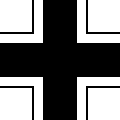Development
Due to the technical construction of the Panzer III and Panzer IV having strong similarities, in September 1941 design meetings were held to create a new and unified tank chassis based on those two tanks. Encouraging this plan were developments both tanks had undergone during their production runs, which made the two tanks even more unified than their initial designs had intended. It was anticipated that unifying the two tanks would result in overall cost reductions in production, supply, training and maintenance. [1] In a notable deviation from either the Panzer III or Panzer IV, this design for the Panzer III/IV concept used schachtellaufwerk suspension. This design settled on use of the Panzer III turret, but with a hydraulic powered traverse system instead of the existing manual traverse. [1] The Panzer III/IV was to have 50mm of protection all-around. Designers unifying the two distinct hulls were concerned about the 23.5 ton weight limitation of the project, and suggested reducing to 40mm thickness the rear armor and parts of the side armor covered by the running gear. However a brief from September 14 of 1941 sent to the Panzer III/IV designers from the German Armament Staff stated that it was acceptable to exceed the project's weight limit due to the assumption that Hitler would in any case request greater armor protection for the vehicle before the design would be approved for production. [1] Prototypes for this design of the Panzer III/IV, using the Panzer III turret and schachtellaufwerk suspension, would be produced. However, by 1942 it was evident that the Panzer III turret (in conjunction with the Panzer III/IV's hull design and suspension) would not be sufficient to mount the powerful new tank guns being developed. The design team abandoned this version of Panzer III/IV, but would continue development of the concept with updated designs.
On 4 January 1944, the Panzerkomission finally approved an updated PzKpfw III/IV design. This new vehicle design had an armor layout focused on frontal armor, and utilized a redesigned hull front incorporating aggressively sloped armor. The lower front of the hull came to a point, consisting of two 60mm thick armor plates (sloped at 60 degrees from vertical on the upper plate, and 45 degrees on the lower plate), whereas the upper front of the hull was a single 80mm thick plate set somewhat further back (sloped at 50 degrees from vertical). The sides of the superstructure were 30mm thick on this design, equal to that of the 90-degree-vertical side armor on the Panzer IV, but on the Panzer III/IV design they were to be angled at 36 degrees from vertical. [2] This degree of armor sloping was not present on either the PzKpfw III or PzKpfw IV tanks, but did appear on other late-war German tank designs such as the Panther tank.
The Maybach HL120 TRM engine (in use on both the Panzer III and Panzer IV by 1944) was selected for this new project, and was connected to the SSG-77 transmission (also in use on both predecessor tanks by 1944). Further adoptions from the PzKpfw III include the steering gear and reinforced output shafts, final drives, and driving wheels. [2] The engine cooling system from the Panzer IV was to be used by the Panzer III/IV. [2] A novel track design was created for the Panzer III/IV: 540mm wide symmetrical tracks with a central ridge, using cast and formed links (akin to those on the Tiger II). [2] These tracks would be significantly wider than the standard tracks for the Panzer III and Panzer IV, but slightly shorter than the asymmetrical "ostketten" soft terrain tracks used on those tanks. The suspension was a new design: six semi-detached road wheels per side, 660mm in diameter and mounted in pairs on double-bogies using leaf spring suspension. While these road wheels were larger than those of the production Panzer III or Panzer IV, the Panzer IV used a similar double-bogie leaf spring suspension design. The planned turret was a modified variant of the PzKpfw IV Ausf. J turret which used a flexible electrical cable to provide power to the turret, instead of the original variant which used rotary electrical contacts at the base of the turret basket. The traverse angle of the turret was therefor limited to 270 left and right longitudinally. [1]
In June 1944 the decision was made to begin full series production of the Panzer III/IV. Production of the vehicle was planned to commence in February 1945 at Krupp-Grusonverk, [2] however on 12 July 1944, the PzKpfw III/IV project was cancelled because the vehicle did not meet the new requirements for armament capability and armor protection as a result of Soviet tanks encountered on the Eastern Front. [1] The hull from the Panzer III/IV, also known as the "Einheitsfahrgestell" (standard chassis) hull, would remain officially adopted as the basis of the unproduced Jagdpanzer IV/70(E), until the end of the war in 1945. [2]
This page is based on this
Wikipedia article Text is available under the
CC BY-SA 4.0 license; additional terms may apply.
Images, videos and audio are available under their respective licenses.
